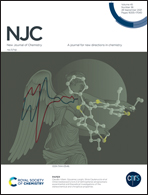New quinoxaline-2(1H)-ones as potential VEGFR-2 inhibitors: design, synthesis, molecular docking, ADMET profile and anti-proliferative evaluations†
Abstract
Eleven new quinoxaline derivatives were designed and synthesized as modified VEGFR-2 inhibitors of our previous work. The synthesized compounds were tested against three human cancer cell lines (HepG-2, MCF-7 and HCT-116). Compounds 11g, 11e and 11c were the most potent members against the tested cells. Compound 11g (IC50 = 4.50, 2.40, and 5.90 μM) was the most potent member compared to doxorubicin (IC50 = 8.29, 9.65, and 7.68 μM) and sorafenib (IC50 = 7.33, 9.41, and 7.23 μM) against HepG-2 and HCT-116, and MCF-7 cell lines, respectively. Compound 11e showed better anti-proliferative activities than doxorubicin and sorafenib with IC50 values of 5.34, 4.19, and 6.06 μM, against HepG-2 and HCT-116 and MCF-7 cell lines, respectively. In addition, the most active anti-proliferative derivatives 11c, 11e, 11f, and 11g were selected to evaluate their inhibitory activities against VEGFR-2. The tested compounds displayed good inhibitory activity with IC50 values ranging from 0.75 to 1.36 μM. Among them, compound 11g was the most active member with an IC50 value of 0.75 μM, compared to the reference drug; sorafenib (IC50 = 1.29 μM). Moreover, docking studies revealed that the synthesized compounds have good binding patterns against the prospective molecular target; VEGFR-2. In addition, in silico, ADMET and toxicity studies showed a high level of drug likeness for the synthesized compounds.



 Please wait while we load your content...
Please wait while we load your content...